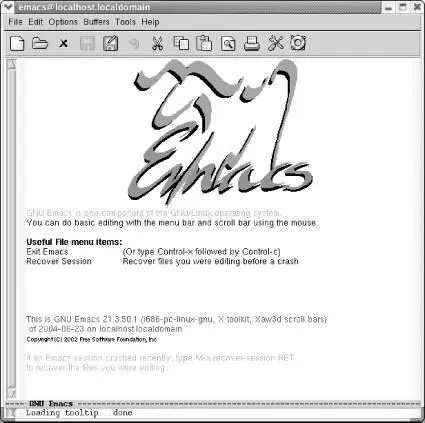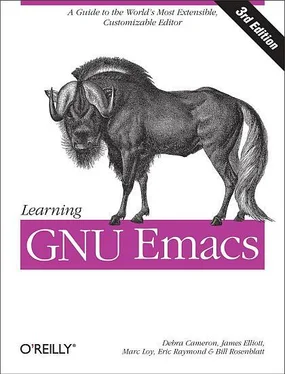There are many other modes that we won't discuss, including modes for some obscure but interesting programming languages (like Modula-2). There are also some other modes that Emacs uses itself, like Dired mode for the directory editing feature (described in Chapter 5 Chapter 5. Emacs as a Work Environment Many of the everyday things you do from a command prompt can be done from within Emacs. You can execute commands, work with directories, and print files—all without leaving Emacs. Changing tasks is as simple as jumping between buffers. What's important about this? Of course, it's nice to be able to move between tasks easily. What's even more important is that you have the same editing environment no matter what you're doing: you can use all of the Emacs editing commands to work on a file, give shell commands, then start up Dired, the directory editor, to do some file maintenance. It is simple to move text from one window to another. You can execute a command and then use Emacs commands to cut and paste the results into a file. If you're trying to compile a program and keep getting error messages, you can save the interactive session as a file and confer with someone about the problem. Despite the many advantages of modern window systems, Emacs often provides the best way to integrate the many kinds of work you do daily. Much of the information in this chapter involves integration between Emacs and the operating system. Emacs is most commonly a Unix editor, so forgive us for a bias in that direction. But we are happy to report that for users of GNU Emacs on other platforms, integration with the operating system is still available; you can use shell mode to run commands and can edit directories with Dired. There's no reason to leave Emacs no matter what your platform is.
).
In addition, if you're good at Lisp programming, you can add your own modes. Emacs is almost infinitely extensible.
To start Emacs, simply click on the Emacs icon or type emacson the command line and press Enter. [5]
Click on the Emacs icon or, from the command line, type: emacs Enter

Starting Emacs.
You'll see a short message describing a few important menu items and the version of Emacs that you're running. It may appear as a graphical splash screen (like the one shown here) or a text splash screen. This message disappears as soon as you type the first character. Emacs then puts you in an (almost) empty buffer called *scratch*, an ideal place for you to experiment.
1.5 About the Emacs Display
When you enter Emacs, you see a large workspace near the top of the window where you do your editing. (See Figure 1-1.)
Figure 1-1. Understanding the Emacs display
A cursor marks your position. The cursor is also called point , particularly among people who are more familiar with Emacs and in the online help system; therefore, it's useful to remember this term.
You don't have to do anything special before you start typing. As long as you type alphanumeric characters and punctuation, Emacs inserts them into your buffer. The cursor indicates where Emacs inserts the new characters; it moves as you type. Unlike many editors (particularly vi), Emacs does not have separate modes for inserting text and giving commands. Try typing something right now, and you'll begin to see how easy Emacs is to use. (If you get stuck for any reason, just press C-g.)
The toolbar is a new feature in Emacs 21. Its basic icons and their functions are listed in Table 1-3. Note that the toolbar is context sensitive; in some modes, such as the Info mode for reading the Emacs manual, the toolbar changes to provide browsing help. We'll discuss those icons when we cover the relevant modes.
Table 1-3. Icons on the Emacs toolbar
| Icon |
Function |
Where to learn more |

Find a file or create a new file (supplying the filename).
This chapter

Start the directory editor so you can manipulate files and folder.
Chapter 5 Chapter 5. Emacs as a Work Environment Many of the everyday things you do from a command prompt can be done from within Emacs. You can execute commands, work with directories, and print files—all without leaving Emacs. Changing tasks is as simple as jumping between buffers. What's important about this? Of course, it's nice to be able to move between tasks easily. What's even more important is that you have the same editing environment no matter what you're doing: you can use all of the Emacs editing commands to work on a file, give shell commands, then start up Dired, the directory editor, to do some file maintenance. It is simple to move text from one window to another. You can execute a command and then use Emacs commands to cut and paste the results into a file. If you're trying to compile a program and keep getting error messages, you can save the interactive session as a file and confer with someone about the problem. Despite the many advantages of modern window systems, Emacs often provides the best way to integrate the many kinds of work you do daily. Much of the information in this chapter involves integration between Emacs and the operating system. Emacs is most commonly a Unix editor, so forgive us for a bias in that direction. But we are happy to report that for users of GNU Emacs on other platforms, integration with the operating system is still available; you can use shell mode to run commands and can edit directories with Dired. There's no reason to leave Emacs no matter what your platform is.

Kill the current buffer.
Chapter 4

Save current buffer in its associated file.
This chapter

Save current buffer as a different file.
This chapter

Undo.
Chapter 2

Cut text that comprises the current region.
Chapter 2

Copy text in current region.
Chapter 2

Paste cut or copied text.
Chapter 2

Search for a string.
Chapter 3 Chapter 3. Search and Replace The commands we discussed in the first two chapters are enough to get you started, but they're certainly not enough to do any serious editing. If you're using Emacs for anything longer than a few paragraphs, you'll want the support this chapter describes. In this chapter, we cover the various ways that Emacs lets you search for and replace text. Emacs provides the traditional search and replace facilities you would expect in any editor; it also provides several important variants, including incremental searches, regular expression searches, and query-replace. We also cover spell-checking here, because it is a type of replacement (errors are sought and replaced with corrections). Finally, we cover word abbreviation mode; this feature is a type of automatic replacement that can be a real timesaver.
Читать дальше























